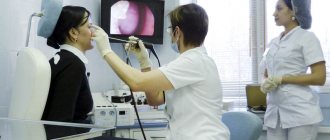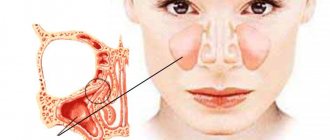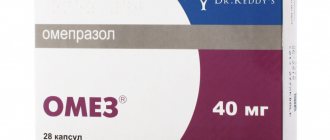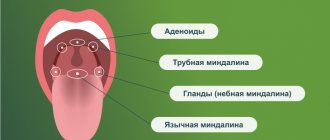Often, adult patients perceive the first symptoms and signs of sinusitis as a normal manifestation of a cold: they uncontrollably take headache pills to relieve pain, and use vasoconstrictor drops to get rid of prolonged runny nose and nasal congestion. An adult, as a rule, neglects going to the doctor and continues to lead his usual lifestyle, sincerely hoping that the measures taken will bring long-awaited relief. But relief does not come. The patient's condition only worsens, and the patient is perplexed as to why the measures he has taken are ineffective.
Sinusitis is one of the most common diseases in otorhinolaryngology. It accounts for a third of all visits to the doctor. There are several types of the disease, so the approaches also differ. Otorhinolaryngologists treat the disease, and only a competent ENT doctor is able to prescribe effective treatment.
How does the disease progress, what are the signs of sinusitis in an adult patient, and what methods of treating this disease are effective? Let's figure it out.
What are the maxillary sinuses
The maxillary sinuses are peculiar cavities located on both sides of the nose. In a healthy state, they are filled with air, and their walls are lined with mucous membrane. They are located above the upper jaw, which led to their second name - maxillary.
Their role should never be underestimated. Due to the fact that the sinuses are filled with air, the weight of our skull decreases. Thanks to them, we better distinguish and capture a variety of odors. All air entering through the nose is purified and heated to the optimal temperature and only then is it delivered to the lungs. The mucous membrane acts as a trap for viruses and bacteria that enter the body through the nose: they settle on the walls of the sinuses and cannot continue their journey further. Sinuses also neutralize the negative effects of sudden temperature changes on the eyes and teeth. As we can see, the functionality is enormous, so it is extremely important to monitor your health so that the correct rhythm of the sinuses is not disrupted. Therefore, when the first signals of a possible disease appear, you need to contact an otolaryngologist, conduct an examination and receive an effective treatment regimen.
Make an appointment right now!
Call us by phone or use the feedback form
Sign up
Causes and mechanisms of the disease
Among the main conditions causing inflammation are:
- past viral diseases;
- diseased teeth (caries, pulpitis);
- allergic reactions;
- deviated nasal septum;
- neoplasms and anatomical features of the nasal cavity that interfere with normal breathing through the nose (for example, with enlarged adenoids in children, cysts, polyps);
- the presence of a focus of chronic infection in the body;
- nasal injuries.
The most common cause of the inflammatory process is infection in the sinuses. The acute form occurs, as a rule, under the influence of viruses. The source of chronic inflammation is often bacteria (staphylococcus, streptococcus and others).
In second place are diseases of the nasopharynx. If a patient suffers from frequent runny noses, the mucous membrane is in a constant state of edema, which prevents the release of mucus. As a result, it accumulates and turns into a favorable environment for the proliferation of bacteria, and as a result, inflammation of the sinuses occurs.
People who often suffer from inflammatory diseases of the pharynx also have a constant source of infection in their bodies, so people with chronic tonsillitis always have a high chance of developing sinusitis.
With a deviated septum, air cannot circulate freely in the nasal cavity, and accordingly, the release of mucus is difficult, which is also a common cause of the inflammatory process. Surgery to correct the septum can solve the problem.
The proximity of the maxillary sinuses to the upper jaw made it possible for infection to penetrate from the teeth. Such inflammations are called odontogenic. To avoid them, you need to carefully monitor oral hygiene and treat problem teeth in a timely manner.
Exposure to allergens on the body leads to prolonged runny nose, swelling of the nasal mucosa and narrowing of the channels that remove mucus. As a result, it accumulates and inflammation occurs.
In the absence of proper treatment of the acute form, it develops into a chronic form with characteristic purulent discharge from the nose. To avoid this, it is necessary to carry out therapy at a very early stage.
Treatment of acute rhinosinusitis
Symptomatic therapy is indicated for patients with ARRS.
- Analgesics and antipyretics - ibuprofen or paracetamol can be used to relieve pain and reduce fever as needed.
- Saline irrigation therapy - Irrigation of the nasal cavity with saline or hypertonic saline can reduce the need for pain medications and improve overall health. It is important that nasal irrigation solutions are sterile, as there is evidence of amoebic encephalitis due to the use of tap water for nasal irrigation.
- Intranasal glucocorticoids (inGCS) - studies have shown small symptomatic benefits and minimal side effects with short-term use of inGCS in patients with both viral and bacterial ARS. InGCS are more effective in patients with concomitant allergic rhinitis. A meta-analysis of three studies in patients with ARS found that intranasal steroids increased the rate of symptom resolution compared with placebo. However, there is also evidence that only 1 out of 15 patients will have a significant reduction in clinical symptoms during treatment with inhaled corticosteroids.
- Ipratropium bromide is an anticholinergic spray that may help reduce rhinorrhea in patients with underlying cold symptoms.
- Oral decongestants may be useful for eustachian tube dysfunction.
- Intranasal vasoconstrictors are often used by patients as symptomatic therapy. Sprays containing oxymetazoline or xylometazoline may provide temporary relief of nasal congestion, but there is no evidence that they are significantly effective for ARS.
In cases of mild, uncomplicated ABRS, there are no indications for prescribing systemic antibiotics; treatment is carried out symptomatically, as in cases of viral infection.
For ABRS, a wait-and-see approach is recommended for 7 days. Systematic reviews and meta-analyses have shown that about 80% of patients with clinically diagnosed ABRS recover without antibiotic therapy within two weeks.
If health does not improve within 7 days or worsens after symptomatic treatment, systemic antibacterial therapy should be added.
The drugs of choice for ABRS are amoxicillin or amoxicillin-clavulanate. The use of an antibiotic with clavulanic acid in its composition expands the spectrum of action of the drug, including against ampicillin-resistant bacteria Haemophilus influenzae or Moraxella catarrhalis. This is not necessary in every case. There is evidence that the use of amoxicillin-clavulanate is preferable in children than in adults. It should also be understood that resistance rates vary depending on the region, which must also be taken into account when selecting therapy.
Preference should be given to amoxicillin-clavulanate in the following cases.
- The patient lives in a region with high rates of penicillin-resistant S. pneumoniae strains (more than 10%).
- Age ≥ 65 years.
- Hospitalization in the last five days.
- Use of antibiotics in the previous month.
- Immunocompromised patients.
- Patients with underlying medical conditions such as diabetes, chronic heart, liver or kidney disease.
- Severe or complicated course of the disease.
If you are allergic to penicillin antibiotics, options for prescribing doxycycline, cephalosporin antibiotics, and clindamycin are considered. Another alternative for patients allergic to penicillins is respiratory fluoroquinolones. However, these drugs should only be used when there is no alternative due to serious side effects.
The duration of the course of antibacterial therapy in adults is usually 5-7 days, in children - 10-14 days. There are studies showing that short courses of antibiotic therapy are not inferior in effectiveness to long courses.
If there is no effect from the first course of antibiotics, the next drug prescribed should have a broader spectrum of activity and/or belong to a different class of drugs.
How is acute rhinosinusitis treated at the Rassvet Clinic?
- We carefully collect anamnesis and conduct an examination.
- We do not prescribe antibiotics unless there is clear evidence that a bacterial infection is developing.
- We do not routinely order x-rays, bacteriological examinations or blood tests. It is not necessary.
- We adhere to the principles of evidence-based medicine, which means that if there are indications for antibiotic therapy, we always give preference to systemic antibiotics, usually oral. Administration of the drug intramuscularly has no proven advantages over tablet forms.
- Not a single local antibiotic has been shown to be effective for ARS, so we do not perform “cuckoo” or multiple punctures of the sinuses and rinse them with “complex solutions.”
- At the Rassvet clinic, you do not need to come to the doctor for control every 2-3 days in cases of the standard course of the disease.
Classification of sinusitis
The diagnosis has several varieties. Highlight:
- by localization of inflammation - unilateral and bilateral
If inflammation covers one sinus, we are dealing with a unilateral disease, if both sinuses are affected, it is bilateral;
- by type of course - acute, subacute and chronic
The acute form lasts up to four weeks, then recovery occurs. Subacute - from four weeks to six months. The most severe is the chronic form, where inflammation lasts more than six months, then a stage of remission occurs, which is again replaced by another exacerbation.
- by etiology (cause of inflammation): viral, bacterial, fungal, allergic, traumatic, aerosinusitis;
- according to symptoms: catarrhal, purulent, serous, hyperplastic, atrophic, polypous.
In the catarrhal form, the nasal mucosa swells and there is a copious flow of clear mucus. In the purulent form, bacteria activate and multiply in the sinuses, causing severe inflammation. A sign of a purulent disease is purulent discharge that emits a foul odor. In the serous form, the discharge is watery. Hyperplastic is similar to purulent, but with this disease there is very severe swelling of the mucous membranes. This form of inflammation very often becomes chronic. With atrophic inflammation, dysfunction of the glands of the mucous membrane of the nasal cavity occurs, and therefore the mucous membrane becomes dry and there is no discharge. The polypous type can be recognized during a special examination - with this form, polyps appear in the nose, blocking the nasal passages and interfering with normal breathing.
Friends! Timely and correct treatment will ensure you a speedy recovery!
Each type of disease requires its own approach and a specific effective therapy for patients.
Symptoms of sinusitis in an adult
An acute disease is accompanied by the following symptoms:
- Unpleasant painful sensations appear around the nose, under the eyes in the cheek area. In the morning the pain is much weaker, but in the evening it intensifies. Pain also appears when turning the head or tilting it to one side.
- The nose is very stuffy. Relief occurs only for a short period of time. Patients notice that their voice begins to sound nasal.
- Greenish nasal discharge. If the nasal passages are completely blocked, there may be no discharge.
- Increased body temperature.
- Lethargy, poor appetite, insomnia are signs of poisoning of the body with waste products of bacteria.
If treatment for the acute form begins late or is chosen incorrectly, the disease can become chronic.
In the chronic form, the signs of the disease are not so pronounced. But persistent nasal congestion, sore throat and cough (since mucus continuously flows down the back wall of the throat), pain under the eyes that occurs with a certain frequency, as well as high fatigue can indicate the presence of chronic inflammation.
Treatment of chronic diseases must also be carried out under the supervision of a competent doctor.
"ENT clinic of Doctor Zaitsev"
Our clinic specializes in the treatment of ear, nose and throat diseases. The most modern equipment, our own techniques and experienced specialists are the three components that will allow you to treat acute sinusitis quickly, safely and effectively. Regular clients of our clinic notice that our prices remain at the 2013 level!
When the first signs of sinusitis appear, please do not delay visiting a doctor. Call and make an appointment - we are always ready to help you!
Complications
Sinusitis is a fairly serious disease, and if treated carelessly, it can become a source of complications.
The most common consequence of the disease is chronicity of the inflammatory process, and as a result, interruptions in the normal functioning of internal organs. With chronic inflammation, air circulation in the nasal cavity is impaired; accordingly, the brain is not sufficiently saturated with oxygen, which affects other body systems.
Inflammation of the sinuses and the presence of a constant source of infection in them cause frequent exacerbations of sinusitis, as well as tonsillitis, bronchitis and pneumonia.
Pathogenic microorganisms can enter the ear cavity from the nasopharynx and cause otitis media.
The most dangerous consequences are meningitis and sepsis.
Remember, treatment of acute inflammation and chronic forms should be carried out in a timely manner and only under the supervision of an ENT doctor.
How to treat sinusitis in adults
The essence of competent therapy is to treat the causes of the disease, and not just relieve the symptoms. As a rule, drug therapy against sinusitis is carried out at home, but subject to strict compliance with all doctor’s instructions. Therapy only with “grandmother’s advice” is unacceptable here. The folk remedy can be used in treatment in parallel with the main methods of therapy, but not instead of them.
The complex of treatment measures usually includes:
- therapy with antibacterial drugs;
- taking antihistamines;
- use of vasoconstrictor drops and nasal rinses;
- taking antipyretic drugs;
- physiotherapy;
- washing the maxillary sinuses using the “cuckoo” method;
- puncture of the maxillary sinus (in particularly advanced cases).
Method of using ointments
All ointments are applied externally. This medicine can be used after clearing the sinuses. To administer it, the product is applied to cotton wool and placed in the nasal passages. Doctors recommend avoiding the use of vasoconstrictor drops when applying ointments, as they can reduce the effect of their effects by narrowing the vessels of the nasal passage.
Only when applied externally to the site of inflammation, the ointment has an antiseptic effect and helps reduce inflammation of the mucous membrane and remove mucous secretions.








